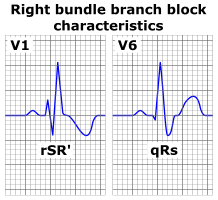Right bundle branch block: Difference between revisions
No edit summary |
No edit summary |
||
| Line 64: | Line 64: | ||
* Familial | * Familial | ||
==Differential Diagnosis== | |||
* [[Pulmonary Embolism|Acute pulmonary embolism]] | |||
* [[Atrial septal defect]] | |||
* [[Ddx:Cardiomyopathy|Cardiomyopathy]] | |||
* [[Cor Pulmonale]] | |||
* [[Coronary Heart Disease]] | |||
* [[Lenegre's Disease]] | |||
* [[Lev's Disease]] | |||
* [[STEMI|Myocardial Infarction]] | |||
* [[Myocarditis]] | |||
---- | ---- | ||
Revision as of 16:49, 17 October 2012
| Right bundle branch block | |
 | |
|---|---|
| ECG characteristics of a typical RBBB showing wide QRS complexes with a terminal R wave in lead V1 and slurred S wave in lead V6. | |
| ICD-10 | I45.1 |
| DiseasesDB | 11620 |
|
Right bundle branch block Microchapters |
|
Differentiating Right bundle branch block from other Diseases |
|---|
|
Diagnosis |
|
Treatment |
|
Case Studies |
|
Right bundle branch block On the Web |
|
American Roentgen Ray Society Images of Right bundle branch block |
|
Risk calculators and risk factors for Right bundle branch block |
Editor-In-Chief: C. Michael Gibson, M.S., M.D. [1] Associate Editor-In-Chief: Cafer Zorkun, M.D., Ph.D. [2]
Synonyms and keywords: RBBB
Overview
Right bundle branch block (RBBB) results from a defect in the heart's electrical conduction system. There is a delay in failure of transmission of electrical impulses down the right bundle of the heart. As a result, the right ventricle depolarizes by an alternate mechanism. This is by means of cell-to-cell conduction. These cell to cell conduction impulses spread more slowly than usual from the interventricular septum to the left ventricle and to the right ventricle. This delay in conduction results in the characteristic ECG pattern which is a wide and notched QRS. Although conduction down the right bundle is delayed, conduction down the left bundle is normal. As result, the interventricular septum and left ventricle depolarize in the normal fashion.
Pathophysiology
Three types of RBBB have been identified based upon electrophysiologic studies.
In each of the three types of RBBB, the surface ECG pattern remains the same.
1. Proximal, or central, RBBB: This type of conduction defect occurs when the conduction block is located just distal to the bundle of His in the superior aspect of the right bundle branch. This type of block occurs when the proximal bundle is injured during surgery for an inlet or membranous ventricular septal defect (VSD).
2. Interruption between the proximal and distal aspects of the right bundle branch: This type of right bundle branch block occurs when the impulse is interrupted between the proximal and distal aspects of the right bundle branch. This type of bright bundle branch block is most commonly observed after surgical division of the moderator band.
3. Distal RBBB: This form is observed when distal ramifications of the right bundle are disrupted during right ventriculotomy or resection of muscle bundles in the right ventricular outflow tract.
Genetics
There can be familial cases of right bundle branch block such as that observed in 4 Lebanese families and the abnormality was mapped to chromosome 19.
There is a subset of patients with Brugada syndrome who have mutations in SCN5A, the gene encoding for the voltage-gated cardiac sodium channel.
Associated syndromes
- Myotonic dystrophy Other ECG findings include first-degree AV block, left anterior fascicular block, and intraventricular conduction delay. Patients may have arrhythmias and/or Stokes-Adams attacks.
- Brugada syndrome: This syndrome is due to a channelopathy mediated by the SCN5A gene. It is important to note that the RBBB pattern seen in patients with this syndrome is not actually RBBB but is instead due to a repolarization abnormality. In this syndrome, the ECG shows ST-segment elevation in leads V1-V3. Cocaine consumption and / or the use of the antiarrhythmic propafenone may unmask the ECG findings of Brugada syndrome.
Causes of Right Bundle Branch Block
- Surgery for correction of congenital heart disease is the most common cause of RBBB among children any United States. This includes surgery for repair of an isolated VSD or another congenital heart disease that includes a VSD (eg, double-chambered right ventricle, AV canal defect, or tetralogy of Fallot). The incidence of RBBB varies and ranges from 25-81% after repair of a VSD to 60-100% after repair of tetralogy of Fallot. The risk of RBBB after surgery varies depending upon the proximity of the VSD to the His-Purkinje system.
- Blunt trauma
- Polymyositis
- Premature atrial contractions or supraventricular tachycardia may cause a transient form up right bundle branch block. This occurs when a premature impulse is conducted from the AV node to the His bundle while the right bundle branch remains in its refractory period, but the left bundle is not. As a result, conduction down the right bundle branch is delayed or blocked.
- Prenatal exposure to each one HIV type 1 may cause right anterior hemiblock.
- Familial
Differential Diagnosis
- Acute pulmonary embolism
- Atrial septal defect
- Cardiomyopathy
- Cor Pulmonale
- Coronary Heart Disease
- Lenegre's Disease
- Lev's Disease
- Myocardial Infarction
- Myocarditis
Overview
Historical Perspective
Pathophysiology
Causes
Epidemiology and Demographics
Risk Factors
Natural History, Complications and Prognosis
Diagnosis
History and Symptoms | Physical Examination | Laboratory Findings | Electrocardiogram | Echocardiography | Other Imaging Findings | Other Diagnostic Studies
Treatment
Medical Therapy | Surgery | Primary Prevention | Secondary Prevention | Cost-Effectiveness of Therapy | Future or Investigational Therapies